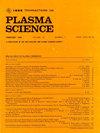Classification of Partial Discharge Sources in Oil-Pressboard Insulation Through a Statistical Approach Based on Detrended Fluctuation Analysis
IF 1.3
4区 物理与天体物理
Q3 PHYSICS, FLUIDS & PLASMAS
引用次数: 0
Abstract
This article introduces a novel approach to characterize the partial discharge (PD) sources present in the oil-pressboard insulation depending on the origin and type of PD sources. Three different types of PD sources, including internal void, corona, and surface discharges, were created using oil-pressboard insulation samples and appropriate electrode setups in the laboratory. PD measurements were performed using a high-frequency current transformer (HFCT) and an oscilloscope with different combinations of the aforementioned defects kept in parallel. PD pulses were extracted from the measured data, and a well-known signal processing algorithm, detrended fluctuation analysis (DFA), was implemented on these pulses. Two statistical features associated with the DFA processed signals, median and skewness, were calculated, and it was found that the PD pulses coming from different sources formed well-defined clusters in the 2-D scatter plot of median versus skewness. The clustering was performed using a clustering algorithm called density-based spatial clustering application with noise (DBSCAN). Later, PD sources were identified by comparing the phase-resolved PD (PRPD) patterns corresponding to each cluster with those obtained under single-defect cases. The developed methodology is easy to implement, does not require complex optimization techniques, and classified PD signals with an accuracy in the range of 93%–97%.基于去趋势波动分析的油压板绝缘局部放电源的统计分类
本文介绍了一种根据局部放电源的来源和类型来表征油压板绝缘中局部放电源的新方法。在实验室中使用油压板绝缘样品和适当的电极设置创建了三种不同类型的PD源,包括内部空洞、电晕和表面放电。PD测量使用高频电流互感器(HFCT)和示波器进行,示波器将上述缺陷的不同组合保持并联。从测量数据中提取PD脉冲,并对这些脉冲进行去趋势波动分析(DFA)。计算了与DFA处理信号相关的中位数和偏度两个统计特征,发现来自不同来源的PD脉冲在中位数与偏度的二维散点图中形成了明确的簇。采用基于密度的空间聚类应用(DBSCAN)聚类算法进行聚类。随后,通过比较每个簇对应的相分辨PD (PRPD)模式与单缺陷情况下获得的模式来识别PD源。所开发的方法易于实现,不需要复杂的优化技术,对PD信号的分类精度在93%-97%之间。
本文章由计算机程序翻译,如有差异,请以英文原文为准。
求助全文
约1分钟内获得全文
求助全文
来源期刊

IEEE Transactions on Plasma Science
物理-物理:流体与等离子体
CiteScore
3.00
自引率
20.00%
发文量
538
审稿时长
3.8 months
期刊介绍:
The scope covers all aspects of the theory and application of plasma science. It includes the following areas: magnetohydrodynamics; thermionics and plasma diodes; basic plasma phenomena; gaseous electronics; microwave/plasma interaction; electron, ion, and plasma sources; space plasmas; intense electron and ion beams; laser-plasma interactions; plasma diagnostics; plasma chemistry and processing; solid-state plasmas; plasma heating; plasma for controlled fusion research; high energy density plasmas; industrial/commercial applications of plasma physics; plasma waves and instabilities; and high power microwave and submillimeter wave generation.
 求助内容:
求助内容: 应助结果提醒方式:
应助结果提醒方式:


